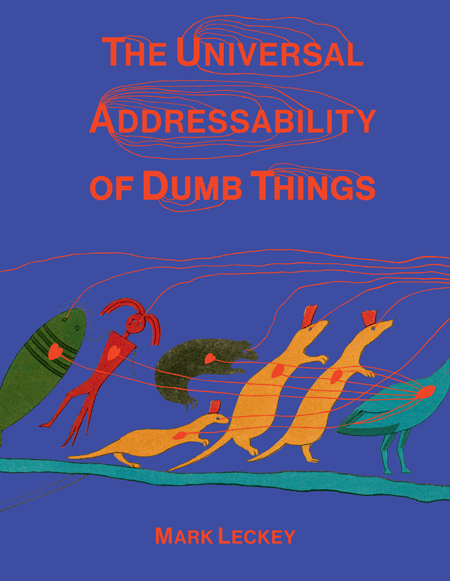
Artist Mark Leckey’s Wunderkammer
The following is a catalog essay I wrote for Mark Leckey’s exhibition The Universal Addressability of Dumb Things, which debuted at the Nottingham Contemporary in 2013. A lecture on the new animism I gave at the Nottingham is available here. Though focused on Leckey’s wonderful exhibit, it continues my exploration on animist revival.
One of the recurring bits on the old kid’s program Sesame Street featured four objects, three of which formed a more or less obvious set. “One of these things is not like the others,” went the ditty. “One of these things doesn’t belong.” But what do we do with a collection where nothing–or everything–“belongs”? Exploring Mark Leckey’s curated assemblage, we confront a hugely heterogeneous collection, marvels at once archaic and utterly now: the clay idol of an automobile prototype, a hieratic uterine vase, a Chippewa political document that has the imaginative economy of a Paul Klee drawing. We sense that these objects do belong together in some way, but how? We are certainly presented with some categories—sets of machines, beasts, human bodies–but these immediately begin to dissolve into one another. Nor do these catch-alls satisfy our deeper suspicion that a more enigmatic and urgent network of questions and concerns confronts us through and behind these particular images and objects. They are exemplars, but of what? Not themselves, certainly. Indeed, many if not most of Leckey’s selections could have been substituted with some other wonder—an early Disney cartoon, a Renaissance automata, a Cornell box—without disturbing the logic of sense engineered by the configurations and correspondences of Leckey’s mash-up menagerie.
Back in the 1990s, my fellow music journalists and I would often complain that “everybody’s a rock critic.” Nowadays, of course, everybody’s a curator. The mediascape is choked with filters and selectors that provide us with an endless stream of playlists, YouTube channels, “Top Ten” blog entries, tweet feeds of filtered URLs, and celebrity mix tapes (even rock musicians are now rock critics, it seems). DJs, film programmers, even chefs, have been reframed as curators. With The Universal Addressability of Dumb Things, Leckey now joins a handful of artists—including Mark Wallinger, Michael Craig-Martin, and Tacita Dean—who have curated exhibits for Hayward Touring. Why this emphasis on curation—on gathering, filtering, selecting, framing, juxtaposing? Because curation is the native art of the network, and the network—digital, neural, bacterial, financial—now dominates our lives. It has become our latest implacable paradigm. Indeed, even the increasingly intelligent behavior of the applications and processes we encounter on the Internet—Google searches, shopping recommendations, ads that follow us across multiple websites—reflect a kind of personalized curation carried out by algorithms acting on the copious crumbs of data our online doppelgängers leave behind. Obviously, the rise of curation as a dominant and self-conscious cultural practice is an intelligent and creative response to the informational complexity and data overload of the world today. But it can also be seen as a belated and even parasitic symptom of archive fever and the anxieties of hyper-production, as we resort to glass bead games played not, as in Hermann Hesse’s novel, out of serene spirituality and massive erudition, but as a sometimes playful and sometimes desperate reframing of the fact that, as far as the various networks that compose us are concerned, “we” are already nothing more than nodes.
As an expression of twenty-first century omniculture, The Universal Addressability of Dumb Things also resonates with other eras when the shifting arts of curation and collection reflected epoch-defining forces. For example, with its gathering of paintings and natural oddities, of archaic exotica and visionary machines, Leckey’s exhibition cannot help but call to mind the Wunderkammer of the early modern era. These well-known collections of natural oddities, mechanical toys, fossils, contemporary paintings, sculptures, and colonized exotica allowed their owners to imaginatively seize a rapidly expanding world through an intermediation of unusual objects. The displays blended spectacle with the natural philosophy later called “science”, and their surrealistic air reflects profound fluctuations of cognitive categories and the emerging boundaries of modern knowledge—a particularly Leckeyesque example here would be the narwhal tusks often found in Wunderkammer collections, a natural oddity that was often framed as a unicorn relic. But the real magic of these collections lays not so much in the objects themselves, but in the cross-talk they established and the dynamic way they drew the observer into the conversation. As Barbara Stafford puts it, these cabinets did not present a static tableau but rather “a drama of possible relationships to be explored.” As the organization of knowledge changed in the early modern era, the drama of these relationships also changed, becoming less imaginative and more abstract and methodical. Even as they kept one foot in phantasmagoria, Wunderkammer also functioned as prototypes of the modern museum, whose encyclopedic aims and organizational frameworks would help concretize the new conceptual universe of Enlightenment rationality.
Emerging in the Renaissance and carrying through the eighteenth and even nineteenth centuries, the Wunderkammer can therefore be seen as transitional object-assemblages that mediate between very different ways of organizing, perceiving, and understanding the world—conceptual paradigms that the early Foucault called epistemes. Foucault drew a strong distinction between a Renaissance episteme based on resemblance, analogy, and occult signatures and a subsequent Enlightenment regime, which rejected that resonating mirror show of images for taxonomy, strict filiation, and rationalized, abstractly defined relationships. This Enlightenment episteme transformed the organization of knowledge—the order of things—but it also transformed the world, entering into the very folds of perception and experience. It did so by driving a wedge between things and meanings, establishing what Bruno Latour characterized as the fundamental logic of modernity. Within the paradigm shift Latour described, a radical distinction is drawn between natural objects and human culture, two domains that had formerly been braided into one resonating reality composed of hybrid objects that were at once natural and cultural. This was the old “anthropological matrix” of fates and fetishes that modernity claimed to set itself resolutely against. No more unicorn tusks.
However, the older episteme did not disappear—it was just pushed to the margins, where it persisted and mutated inside the worlds of literature, popular entertainment, fringe science (and tech), “madness,” and the esoteric underground. Which brings us back to curation, and the art—rather than the science—of gathering together meaningful objects and images. Among the many modes of curation, there is an enigmatic style whose orchestration of juxtapositions and resonances can lend an occult air of significance to the resulting collection, a kind of portmanteau discourse of visionary hybrids. Surrealists exploited this combinatory power to détourné consciousness in the direction of Freudian slip-knots and alchemical desire; personal altars and the bohemian art of thrift-store interior design are informal examples of such curated mysteries. Similarly, it is hardly accidental that the logic of dreams and esoteric correspondences runs so deep in the modern arts of collage and assemblage. Like Andy Holden’s cosmic collage, included in Leckey’s exhibit, such media gather objects and images—often quotidian or even corny on their own—into larger assemblages that both reflect on and intensify the essential enigma of things—the possibility, Holden playfully suggests, that the universe is looking back at us. As if by magic, a gathering of objects calls forth a pattern that connects. The more heterogeneous the objects—in Leckey’s show, we have Pop Art canvases, Minotaur heads, car engines, canopic jars, Wurlitzer drum machines—the more feverish that linking pattern grows. Think of it as object-oriented invocation.
In particular, Leckey wants to invoke the spectral and increasingly animated correspondences between beasts, machines, and the human bodymind. Discourse is not necessary to tap into this invisible matrix of metamorphic figments—indeed, in some ways talking about it just gets in the way. Much may be gained from allowing yourself to daydream or divine your way through Leckey’s labyrinth of phantoms objects, to quiet your own commentary enough to allow the objects themselves to provide their own oracular mumblings. Here the old paradigm of resemblances is close at hand: a camera recalls a tribal fetish, books look like brains, and a mandrake root naturally (magically?) forms a simulacrum of a man. Analog chains of links and puns proliferate and circulate: the wooden model of a cat’s reflex system invokes the Egyptian remains of a cat whose mummification calls up the CT scan—a “cat scan” we say—of a human mummy whose empty sockets demand, in turn, a procession of eyeballs: Toyen’s Objekt-Phantom, and even the Sputnik model that returns to remind us, in a roundabout way, of the curious metallic peepers—jeepers creepers!–of the feline reflex model that began the chain. From this perspective, the show is a rebus whose solution is your own shifting consciousness.
At the same time, Leckey is also setting up a specifically conceptual assemblage, an analytic zeitgeist probe. With his characteristic informality and lack of pretension, Leckey is asking a question, or a set of questions, that happens to take the form of a gathering of symptoms that cross multiple levels of psyche, biology, art, and apparatus.
At the heart of the question lies an observation, or a suspicion, that the science fiction writer Philip K. Dick once voiced in a prescient speech he delivered to the Vancouver Science Fiction Convention in 1972. Dick noted that our environment—by which he meant “our man-made world of machines, artificial constructs, computers, electronic systems, interlinking homeostatic components”—was coming to possess what the first peoples perceived in their environment: animation. Navigating a world of robots, non-player characters, talking technologies, self-improving algorithms, and uncanny feedback arrays, we are increasingly hard-pressed to reject Dick’s fundamental techno-animist claim: “In a very real sense our environment is becoming alive, or at least quasi-alive.”
The artifacts, images, and moving pictures that Leckey has gathered might be said to ride the ambiguous, Möbius strip surface of that “quasi.” The Latin term, we should recall, means “as if”, and as if is perhaps the most fundamental strategy by which people today both experience and attempt to contain the tantalizing and threatening re-enchantment of the world. As cultural commentators from Victoria Nelson to Christopher Partridge have shown us, subcultural enchantment is the fantastic flipside to Max Weber’s famous assertion, not unrelated to Latour’s critique, that the modern world is an iron cage that locks us inside a rationalized matrix that exiles all the old specters. Though figments of the anthropological matrix lurk perpetually at the margins of our minds—in dream leakages, odd hunches, and the occasional mystic transport—the old enchantment is perhaps most visible in the tales told by our cultural artifacts. Fictions run on as if, of course—most obviously fantasy and science fictions, whose viewers and readers are called upon to not only suspend some of our underlying rules of reality but to allow other rules to temporarily take hold within a bounded space of possibility. As such, the as if operator also underlies the vast appeal of role-playing and massive-multiplayer online games and their compulsive elaborations of SF, occult, paranormal, and fantasy rule-sets. Just as the philologist Max Müller once argued that human mythology is “a disease of language,” so the interactive fictions that glaze our objects—virtual and otherwise—might be seen as the emergent expressions of the re-engineered (or imagineered) codes and protocols that increasingly “run” the real.
But today, Dick’s “quasi” goes well beyond obvious fictions. As Michael Saler explains in his book As If, moderns have learned to inhabit an “ironic imagination” that both indulges and disavows the world of enchantment. This is the imagination that allows us to immerse ourselves in fantasies—especially fantasies, like Sherlock Holmes or H.P. Lovecraft’s Cthulhu, that play with their own possible reality—while ironically distancing any conflicts our imaginative assent might create with the rules of the iron cage. Today this mode—Saler calls it “delight without delusion”—increasingly extends to the surfaces of our quotidian lives, albeit often in a less delightful vein. Asking Siri a question as if the iPhone were intelligent, or modifying our social behavior as if it were already being recorded, or following mainstream news stories into the hyperlinked labyrinths of conspiracy as if the truth was really out there, we discover that ironic imagination is no longer confined to obvious fictions but has become a handy rule of engagement with an environment where, as Dick foresaw, intelligence, responsiveness, and something like life—or at least quasi-life—are increasingly distributed through the world of objects.
The problem with the as if approach to our increasingly animist experience of objects, though, is that it roots itself too resolutely in the Modernist schema. This paradigm saps agency from natural and crafted objects and places it entirely on the human side of the equation. In this view, humans “project” meanings onto objects in the environment; indeed the very concept of environment requires the absence of animating energies that would render the surrounding milieu too animate and even willful for such abstraction. To some degree, of course, projection is the appropriate model, since the fluctuation of images through the network is part of the game. The belief that certain plants or mountains have a special occult power is partly related to the fact that some of their shapes—like Leckey’s mandrake root—elicit our own hardwired tendency to find human faces and forms in the world around us. Similarly, we may recognize classic Disney animations as a return to animism, as the brilliant Russian filmmaker Sergei Eisenstein himself did in his writings on the Mouse (“Bambi,” he notes, “is already a shift towards ecstasy—serious, eternal”), but we also know that the mechanically projected 24 frames exploit our own perceptual machinery.
That said, “projection” alone will no longer suffice. The concept simply does not adequately account for the dynamic operations of the assemblage, which draws the human body and psyche into its mesh. Who is projecting Bambi anyway, the psyche or the film machine? Here we must recall Latour’s core dictum that we have never been modern. In other words, the radical distinction opened up between natural things and cultural meanings—the paradigm that gives us “projection”—is an act of legerdemain by the magus Modernity. In contrast, Latrour argues that the emergence of nature-culture hybrids never actually ceased. Indeed, the sleight of hand of the Modern schema encouraged the production of these meshed objects, so much so that today we have reached a point where hybrid networks of machines, biological forms, and cognitive, cultural processes surround and implicate us so pervasively that they seem to compose us as well. And so we sink back into the old anthropological matrix.
The Universal Addressability of Dumb Things is an index—an occult signature—of this shift. If the classic Wunderkammer can be seen as a prologue to the modern order of things, Leckey’s curated assemblage crawls out from the ruin of that order. It is common to note that the material things in our world are increasingly enmeshed in incorporeal matrixes of CAD systems, 3D prototypes, and an ecstasy of digital mediation. At the same time, objects are growing increasingly demanding. The peculiar presence of the things and images of Leckey’s show—which both announce their significance and veil their meanings—is of a piece with what Latour’s network-actor theory and a growing number of object-oriented thinkers recognize as the agency of things. The new object is irreducibly real, but also elusive, uncanny. It has its own moves to make, its own alliances to establish, its own signs to emit. The demands of such a “weird realism” (to use Graham Harman’s phrase) surely block and obstruct the aspirations of modern human consciousness and its aspirations of autonomy, control, and the cognitive correlations between mind and world. The newly awakened object can also be understood in terms of panpsychism—the argument, convincing even to a few hard-nosed neuroscientists, that a measure of mind or consciousness inheres in every single thing in the cosmos. What Leckey shows us is that it doesn’t matter whether these hybrid objects are opaque Others or facets of cosmic consciousness, or both. Whether we are ready to embrace them or not, they are in some sense alive. Or at least, quasi-alive. (Or maybe undead.) In any case, the return of the object is a return of animism of a sort, at least of a weird realism that undermines our blinkered passages through a merely human reality. Might as well meet the neighbors.




